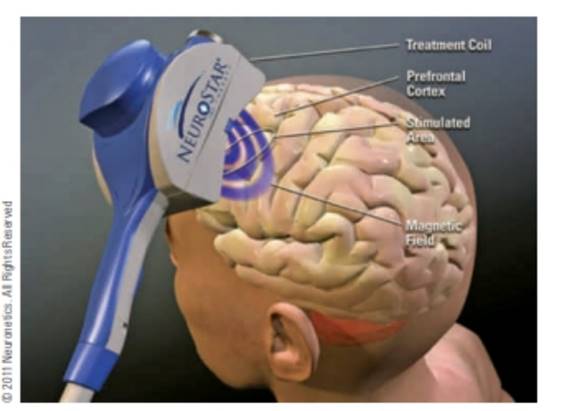
Transcranial magnetic stimulation (TMS) is a noninvasive technique used to stimulate tedious of the human brain (Figure P31.3). In TMS, a small coil is placed on the scalp and a brief burst of current in the coil produces a rapidly changing magnetic field inside the brain. The induced emf can stimulate neuronal activity. (a) One such device generates an upward magnetic Held within the brain that rises from zero to 1.50 T in 120 ms. Determine the induced emf around a horizontal circle of tissue of radius 1.60 mm. (b) What If? The field next changes to 0.500 T downward in 80.0 ms. How does the emf induced in this process compare with that in part (a)?

Figure P31.3 Problems 3 and 51. The magnetic coil of a Neurostar TMS apparatus is held near the head of a patient.
Trending nowThis is a popular solution!

Chapter 31 Solutions
EBK PHYSICS FOR SCIENTISTS AND ENGINEER
- 4.4 A man is dragging a trunk up the loading ramp of a mover's truck. The ramp has a slope angle of 20.0°, and the man pulls upward with a force F whose direction makes an angle of 30.0° 75.0° with the ramp (Fig. E4.4). (a) How large a force F is necessary for the component Fx parallel to the ramp to be 90.0 N? (b) How large will the component Fy perpendicular to the ramp be then? Figure E4.4 30.0 20.0°arrow_forward1. * A projectile is shot from a launcher at an angle e, with an initial velocity magnitude v., from a point even with a tabletop. The projectile lands on the tabletop a horizontal distance R (the "range") away from where it left the launcher. Set this up as a formal problem, and solve for vo (i.e., determine an expression for Vo in terms of only R, 0., and g). Your final equation will be called Equation 1.arrow_forward2. A projectile is shot from a launcher at an angle 0,, with an initial velocity magnitude vo, from a point even with a tabletop. The projectile hits an apple atop a child's noggin (see Figure 1). The apple is a height y above the tabletop, and a horizontal distance x from the launcher. Set this up as a formal problem, and solve for x. That is, determine an expression for x in terms of only v₁, o,y and g. Actually, this is quite a long expression. So, if you want, you can determine an expression for x in terms of v., 0., and time t, and determine another expression for timet (in terms of v., 0., y and g) that you will solve and then substitute the value of t into the expression for x. Your final equation(s) will be called Equation 3 (and Equation 4).arrow_forward
- 4.56 ... CALC An object of mass m is at rest in equilibrium at the origin. At t = 0 a new force F(t) is applied that has components Fx(t) = k₁ + k₂y Fy(t) = k3t where k₁, k2, and k3 are constants. Calculate the position (1) and veloc- ity (t) vectors as functions of time.arrow_forward4.14 ⚫ A 2.75 kg cat moves in a straight line (the x-axis). Figure E4.14 shows a graph of the x- component of this cat's velocity as a function of time. (a) Find the maximum net force on this cat. When does this force occur? (b) When is the net force on the cat equal to zero? (c) What is the net force at time 8.5 s? Figure E4.14 V₁ (m/s) 12.0 10.0 8.0 6.0 4.0 2.0 0 t(s) 2.0 4.0 6.0 8.0 10.0arrow_forward4.36 ... CP An advertisement claims that a particular automobile can "stop on a dime." What net force would be necessary to stop a 850 kg automobile traveling initially at 45.0 km/h in a distance equal to the di- ameter of a dime, 1.8 cm?arrow_forward
- 4.46 The two blocks in Fig. P4.46 are connected by a heavy uniform rope with a mass of 4.00 kg. An up- ward force of 200 N is applied as shown. (a) Draw three free-body diagrams: one for the 6.00 kg block, one for B the 4.00 kg rope, and another one for the 5.00 kg block. For each force, indicate what object exerts that force. (b) What is the acceleration of the system? (c) What is the tension at the top of the heavy rope? (d) What is the tension at the midpoint of the rope? Figure P4.46 F= 200 N 4.00 kg 6.00 kg 5.00 kgarrow_forward4.35 ⚫ Two adults and a child want to push a wheeled cart in the direc- tion marked x in Fig. P4.35 (next page). The two adults push with hori- zontal forces F and F as shown. (a) Find the magnitude and direction of the smallest force that the child should exert. Ignore the effects of friction. (b) If the child exerts the minimum force found in part (a), the cart ac- celerates at 2.0 m/s² in the +x-direction. What is the weight of the cart? Figure P4.35 F₁ = 100 N 60° 30° F2 = 140 Narrow_forward4.21 ⚫ BIO World-class sprinters can accelerate out of the starting blocks with an acceleration that is nearly horizontal and has magnitude 15 m/s². How much horizontal force must a 55 kg sprinter exert on the starting blocks to produce this acceleration? Which object exerts the force that propels the sprinter: the blocks or the sprinter herself?arrow_forward
- No chatgpt pls will upvotearrow_forwardPlease don't use Chatgpt will upvote and give handwritten solutionarrow_forwardThe kinetic energy of a pendulum is greatest Question 20Select one: a. at the top of its swing. b. when its potential energy is greatest. c. at the bottom of its swing. d. when its total energy is greatest.arrow_forward
 Physics for Scientists and Engineers, Technology ...PhysicsISBN:9781305116399Author:Raymond A. Serway, John W. JewettPublisher:Cengage Learning
Physics for Scientists and Engineers, Technology ...PhysicsISBN:9781305116399Author:Raymond A. Serway, John W. JewettPublisher:Cengage Learning Principles of Physics: A Calculus-Based TextPhysicsISBN:9781133104261Author:Raymond A. Serway, John W. JewettPublisher:Cengage Learning
Principles of Physics: A Calculus-Based TextPhysicsISBN:9781133104261Author:Raymond A. Serway, John W. JewettPublisher:Cengage Learning College PhysicsPhysicsISBN:9781285737027Author:Raymond A. Serway, Chris VuillePublisher:Cengage Learning
College PhysicsPhysicsISBN:9781285737027Author:Raymond A. Serway, Chris VuillePublisher:Cengage Learning College PhysicsPhysicsISBN:9781305952300Author:Raymond A. Serway, Chris VuillePublisher:Cengage Learning
College PhysicsPhysicsISBN:9781305952300Author:Raymond A. Serway, Chris VuillePublisher:Cengage Learning Glencoe Physics: Principles and Problems, Student...PhysicsISBN:9780078807213Author:Paul W. ZitzewitzPublisher:Glencoe/McGraw-Hill
Glencoe Physics: Principles and Problems, Student...PhysicsISBN:9780078807213Author:Paul W. ZitzewitzPublisher:Glencoe/McGraw-Hill College PhysicsPhysicsISBN:9781938168000Author:Paul Peter Urone, Roger HinrichsPublisher:OpenStax College
College PhysicsPhysicsISBN:9781938168000Author:Paul Peter Urone, Roger HinrichsPublisher:OpenStax College





